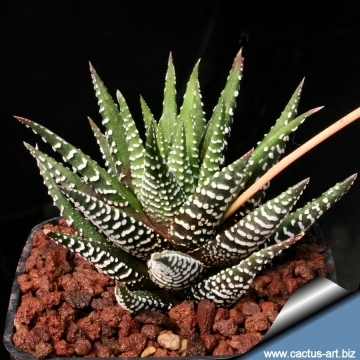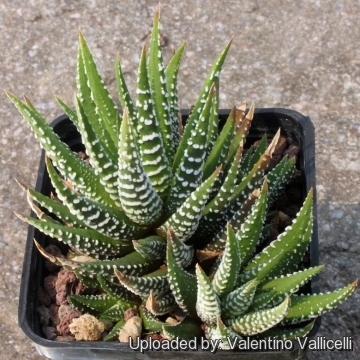




Your support is critical to our success.
Accepted Scientific Name: Haworthia attenuata (Haw.) Haw.
Syn. Pl. Succ. 92.

This is a striking plant with pointed leaves banded with white transversal stripes and spots that forms fast beautiful clusters. It is highly variable and offsets profusely with several forms, variety and cultivars.
Origin and Habitat: Hankey to the Fish River, Eastern Cape, South Africa.
Habitat: It grows often under bushes, seeking a little shade from the fierce sun in the Bushveld and dry Karroid scrub community.
Synonyms:
- Haworthia attenuata (Haw.) Haw.
- Aloe attenuata Haw.
- Aloe radula Ker Gawl. non Jacq.
- Apicra attenuata (Haw.) Willd.
- Catevala attenuata (Haw.) Kuntze
- Haworthia pumila subs. attenuata (Haw.) Halda
- Haworthiopsis attenuata (Haw.) G.D.Rowley
Haworthia attenuata (Haw.) Haw.
Syn. Pl. Succ. 92.
Synonymy: 30
- Haworthia attenuata (Haw.) Haw.
- Aloe attenuata Haw.
- Aloe radula Ker Gawl. non Jacq.
- Apicra attenuata (Haw.) Willd.
- Catevala attenuata (Haw.) Kuntze
- Haworthia pumila subs. attenuata (Haw.) Halda
- Haworthiopsis attenuata (Haw.) G.D.Rowley
- Haworthia attenuata var. argyrostigma (Baker) A.Berger
- Haworthia argyrostigma Baker
- Haworthia attenuata var. britteniae (Poelln.) Poelln.
- Haworthia attenuata f. britteniae (Poelln.) M.B.Bayer
- Haworthia britteniae Poelln.
- Haworthia attenuata var. caespitosa (A.Berger) R.S.Farden
- Haworthia attenuata f. caespitosa (A.Berger) Pilbeam
- Haworthia fasciata var. caespitosa A.Berger
- Haworthia attenuata var. clariperla (Haw.) Baker
- Aloe attenuata var. clariperla (Haw.) Salm-Dyck
- Aloe clariperla (Haw.) Schult.f.
- Haworthia attenuata f. clariperla (Haw.) M.B.Bayer
- Haworthia clariperla Haw.
- Haworthia attenuata var. deltoidea R.S.Farden
- Haworthia attenuata var. inusitata R.S.Farden
- Haworthia attenuata var. linearis R.S.Farden
- Haworthia attenuata var. minissima R.S.Farden
- Haworthia attenuata var. odonoghueana R.S.Farden
- Haworthia attenuata var. uitewaaliana R.S.Farden
- Haworthia attenuata f. variegata
- Haworthia tisleyi Baker
- Catevala tisleyi (Baker) Kuntze
Haworthia attenuata var. radula (Jacq.) M.B.Bayer
Haworthia Revisited 167 (1999)
Synonymy: 24
- Haworthia attenuata var. radula (Jacq.) M.B.Bayer
- Aloe radula Jacq.
- Apicra radula (Jacq.) Willd.
- Catevala radula (Jacq.) Kuntze
- Haworthia pumila var. radula (Jacq.) Halda
- Haworthia radula (Jacq.) Haw.
- Haworthiopsis attenuata var. radula (Jacq.) G.D.Rowley
- Haworthia attenuata var. radula f. variegata hort.
- Haworthia radula var. laevior Haw.
- Haworthia radula var. magniperlata Haw.
- Haworthia radula var. major (Salm-Dyck)
- Aloe radula var. major Salm-Dyck
- Haworthia radula var. minor (Salm-Dyck)
- Aloe radula var. minor Salm-Dyck
- Haworthia radula var. pluriperlata (Salm-Dyck) Haw.
- Haworthia rugosa (Salm-Dyck) Baker
- Aloe rugosa Salm-Dyck
- Catevala rugosa (Salm-Dyck) Kuntze
- Haworthia rugosa var. perviridis (Salm-Dyck) A.Berger
- Aloe rugosa var. perviridis Salm-Dyck
- Haworthia subulata (Salm-Dyck) Baker
- Aloe subulata Salm-Dyck
- Catevala subulata (Salm-Dyck) Kuntze
ENGLISH: Zebra Plant
Description: It is a low growing and almost stemless clustering perennial-succulent. It is easily recognizable by the white pearly warts that densely cover the dark-green leaves. It can eventually form large mat-like clumps and is one of the most common species in cultivation. It is very variable, comes in many varieties and forms ranging from solid green with only few tiny white bumps to heavily white horizontal banded forms, and also individual clump that has broad, heavy horizontal stripes will sometimes throw off a pup with just bumps, or some will be smoother, knobbier, etc., and vice-versa. One problem with Gasteria is that there are so many hybrids between species, seedling variability and differences between juvenile and adult plants, that it becomes almost impossible to distinguish many forms from one another. Particularly the name “attenuata” is used for wildly different forms and can cause confusion.
Rosettes: Almost stemless, 6-12cm diameter, 6-13(25) cm tall, heavily clumping.
Leaves: Dark green, concave, slender, pointed and strikingly banded or spotted with white (hence the common name zebra plant). Tubercles are "patterned" on the upper surface of the leaves. The lower surface of the leaves have transverse bands of tubercles
Flowers: Relatively inconspicuous white-greenish.
Bloom time: Can be ever blooming if you snip off each bloom when it dies.
Subspecies, varieties, forms and cultivars of plants belonging to the Haworthia attenuata group
 Haworthia attenuata (Haw.) Haw.: Stemless clustering succulent with pointed leaves banded with white transversal stripes and spots. It is highly variable and offsets profusely with several forms and variety.
Haworthia attenuata (Haw.) Haw.: Stemless clustering succulent with pointed leaves banded with white transversal stripes and spots. It is highly variable and offsets profusely with several forms and variety.- Haworthia attenuata var. argyrostigma (Baker) A.Berger
- Haworthia attenuata var. britteniae (Poelln.) Poelln.
- Haworthia attenuata var. caespitosa (A.Berger) R.S.Farden
 Haworthia attenuata var. clariperla (Haw.) Baker: Form with numerous raised white dots on the leaves (rarely merged to form short lines)
Haworthia attenuata var. clariperla (Haw.) Baker: Form with numerous raised white dots on the leaves (rarely merged to form short lines)- Haworthia attenuata var. deltoidea R.S.Farden
- Haworthia attenuata var. inusitata R.S.Farden
- Haworthia attenuata var. linearis R.S.Farden
- Haworthia attenuata var. minissima R.S.Farden
- Haworthia attenuata var. odonoghueana R.S.Farden
 Haworthia attenuata var. radula (Jacq.) M.B.Bayer: Has many very minute crowded white tubercles.
Haworthia attenuata var. radula (Jacq.) M.B.Bayer: Has many very minute crowded white tubercles. Haworthia attenuata var. radula f. variegata hort.: has leaves variably striped with yellow or pink.
Haworthia attenuata var. radula f. variegata hort.: has leaves variably striped with yellow or pink.- Haworthia attenuata var. uitewaaliana R.S.Farden
 Haworthia attenuata f. variegata: The evergreen perennial dark green foliage is highlighted with silvery-white, yellow or orange vertical variegation. It is highly variable with several degree of variegation also in the same plant. There are many different clones.
Haworthia attenuata f. variegata: The evergreen perennial dark green foliage is highlighted with silvery-white, yellow or orange vertical variegation. It is highly variable with several degree of variegation also in the same plant. There are many different clones. Haworthia attenuata cv. Wide Zebra: Beautiful plant with strikingly leaves marked with very large white stripes on the under-sides.
Haworthia attenuata cv. Wide Zebra: Beautiful plant with strikingly leaves marked with very large white stripes on the under-sides. Haworthia rugosa (Salm-Dyck) Baker: Has prominent white tubercles arranged in more or less regular lengthwise rows on the leaves.
Haworthia rugosa (Salm-Dyck) Baker: Has prominent white tubercles arranged in more or less regular lengthwise rows on the leaves.

Aloe attenuata (Haworthia attenuata) Photo by: Cactus Art

Aloe attenuata (Haworthia attenuata) Photo by: Valentino Vallicelli
Cultivation and Propagation: They are of easy cultivation, which makes them a good houseplant, and can be an excellent subject for the beginning succulentophile (it can grow easily on window sills, verandas and in miniature succulent gardens where they are happy to share their habitat with other smaller succulent plants, or in outdoor rockeries). The plant needs light shade to shade, but will take full sun part of the day. (with some sun exposure the leaf develops a nice reddish tint and remains compact) They are tolerant of a wide range of soils and habitats, but prefer a very porous potting mix to increase drainage. During the hot summer months, the soil should be kept moist but not overly wet. The plants are fertilized only once during the growing season with a balanced fertilizer diluted to ½ the recommended strength. During the winter months, water only when the soil becomes completely dry.
Propagation: Haworthia are easily propagated by the removal of offshoots or by leaf cuttings in spring or summer. To propagate by leaf cuttings, remove a leaf and let it lie for about one month, giving the wound time to heal. Then lay the leaf on its side with the basal part buried in the soil. This leaf should root within a month or two, and small plants will form at the leaf base. They can also be grown from seed.
| Your Actions | |
|---|---|
| Back to Aloe index | |
| Back to Aloaceae index | |
 |
Back to Succulents Encyclopedia index |
Privacy stantement - Terms and conditions - How to cite - About us - Feedback - Donate



